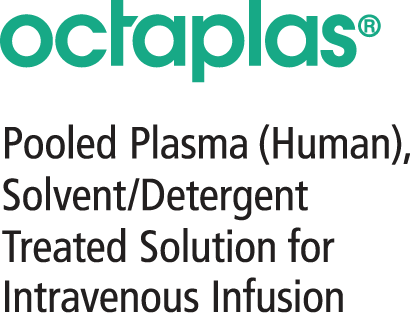Efficacy and Safety of Octaplas for Pediatric Patients
Effects of octaplas in the management of pediatric patients who require replacement of multiple coagulation factors1,2
- Open-label, multicenter, phase 4 (post-marketing) study conducted in 50 enrolled patients <16 years old who required replacement of multiple coagulation factors due to liver dysfunction associated with coagulopathy (n = 5, 10%) and/or required cardiac surgery (n = 40, 80%) or liver transplant surgery (n = 5, 10%)
- All 50 patients had ≥1 infusion episode, ten had 2 infusion episodes, five had 3 infusion episodes and one had 6 infusion episodes of octaplas administered intravenously based on ABO-group compatibility
- Primary endpoints: incidence of serious adverse events (SAEs), adverse drug reactions (ADRs), thrombotic events (TEs), thromboembolic events (TEEs) and hyperfibrinolytic events (HFEs)
| STUDY OBJECTIVES: ASSESS EFFICACY, SAFETY, AND TOLERABILITY OF OCTAPLAS IN PEDIATRIC PATIENTS REQUIRING REPLACEMENT OF MULTIPLE COAGULATION FACTORS | ||||||
|---|---|---|---|---|---|---|
| Occurrence of any SAE2 | Total Population (n = 50) |
Infants ≤ 2 years (n = 37) |
Children > 2 years (n = 13) |
|||
| SAEs n | Patients n (%) | SAEs n | Patients n (%) | SAEs n | Patients n (%) | |
| 9 | 5 (10%) | 3 | 3 (8.1%) | 6 | 2 (15.4%) | |
Conclusions
- For all 50 patients, investigator assessment of safety was “excellent”
- No ADRs, HFEs or treatment-related TEs or TEEs occurred during the study
- No SAEs that occurred were considered to be related to octaplas
- Treatment response appeared favorable in the majority of patients
Effects of octaplas in the management of pediatric patients who require therapeutic plasma exchange1,3
- Open-label, multicenter, phase 4 (post-marketing) study conducted in 41 enrolled patients 2 to 20 years old in whom therapeutic plasma exchange (TPE) was required
- Each subject underwent between 1 and 6 TPEs (mean: 2.5 TPEs). Timeframe: up to 8 days including the 24-hour follow-up from treatment
- Primary endpoints: incidence of serious adverse events (SAEs), adverse drug reactions (ADRs), thrombotic events (TEs), and thromboembolic events (TEEs)
| STUDY OBJECTIVES: ASSESS EFFICACY, SAFETY, AND TOLERABILITY OF OCTAPLAS IN PEDIATRIC PATIENTS REQUIRING THERAPEUTIC PLASMA EXCHANGE | ||||||||
|---|---|---|---|---|---|---|---|---|
| Adverse Drug Reactions (ADRs) Reported in 4 of the 41 (9.8%) Total Patient Population | ||||||||
| Occurrence of ADR | Total Population (n = 41) |
Children Age 2 – <12 (n = 15) |
Adolescents Age 12 – <17 (n = 13) |
Young Adults Age >17 (n = 13) |
||||
| ADRs n | Patients n (%) | ADRs n | Patients n (%) | ADRs n | Patients n (%) | ADRs n | Patients n (%) | |
| 8 | 4 (9.8%) |
0 | 0 (0%) |
5 | 3 (30.76%) |
3 | 1 (23.8%) |
|
Conclusions
- Overall safety was assessed by investigators as excellent for most subjects (>90%)
- No treatment-related SAEs were reported
- No TEs or TEEs were reported
- ADRs reported in 4 of 41 subjects; most adverse reactions (7/8) were mild in intensity and resolved by end of study
Reference:
- Octaplas Full Prescribing Information. Paramus, NJ: Octapharma; rev 2021.
- Spinella, P.C., Borasino, S., and Alten, J., “Solvent/Detergent-Treated Plasma in the Management of Pediatric Patients Who Require Replacement of Multiple Coagulation Factors: An Open-Label, Multicenter, Post-marketing Study”, Frontiers in Pediatrics. 2020;8:572.
- Josephson, C.D. et al., “Safety and tolerability of solvent/detergent-treated plasma for pediatric patients requiring therapeutic plasma exchange: An open-label, multicenter, postmarketing study”, Transfusion. 2022;62:396-405.
